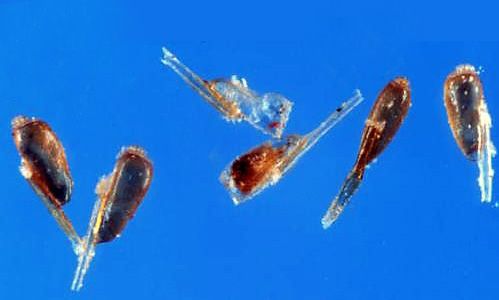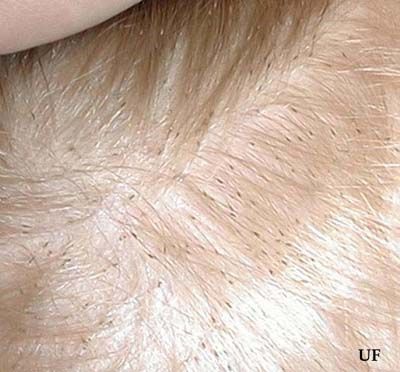Summary
We often hear “My head is itchy. Do I have lice?” The Integrated Pest Management (IPM) in the Home Series initiative is intended to provide answers to frequently asked questions from the public.
According to the Center for Disease Control and Prevention (CDC), head lice, or Pediculus humanus capitis, are ectoparasitic insects that can be found in people’s hair, including their eyebrows, and, in rare cases, their eyelashes. Head lice feed on human blood and live close to the human scalp. Head lice are not known to spread disease. They are not known to live in the hair of pets or other animals. Head lice are small (approximately 2.5–3 mm or 0.12 in long) and grayish-white or tan (or darker when they have fed recently and are full of blood). Head lice spread by human contact, and they do not survive long without a human host.
What are head lice?
Head lice (Pediculus humanus capitis De Geer) are ectoparasitic insects that infest the human scalp and feed on blood. They are the size of a sesame seed (approximately 2.5–3 mm long) and are grayish-white or tan. They may be darker in color when they have fed. Lice move by crawling. They cannot fly. The primary symptom of head lice infestation is intense itching. Head lice are different from body and pubic lice. Head and body lice are different subspecies of the same species. Pubic lice are a different species entirely.
How do people get head lice?
Head lice are spread by direct contact with the hair of an infested person. In the United States, head lice are found on 6 to 12 million 3- to 11-year-old children each year (CDC 2019). While it is less common for lice to spread through contact with clothing such as hats, scarves, coats, or other personal items such as combs, brushes, or towels used by an infested person, it is still a good idea not to share these items. Head lice are not always an indication of poor personal hygiene, although good personal hygiene is helpful in head lice detection and management.
How can I check for head lice?
It is important to know what to look for when inspecting for head lice. Head lice start as eggs, commonly called “nits” (Figure 1). Nits are tightly glued to the hair shaft close to the scalp (Figure 2). Inspect carefully behind the ears and at the nape of the neck. Nits that are found >¼ inch away from the scalp are no longer viable. Nymphs (immature lice) hatch from nits. You may see different sized nymphs that sequentially molt to male and female adults (Figure 3). A visual inspection of your hair and scalp is effective in detecting head lice or contact your primary care provider if you suspect head lice.

Credit: C. Scherer, UF/IFAS

Credit: Clay Scherer, UF/IFAS

Credit: Lyle Buss, UF/IFAS
Best head lice inspection, removal, and management practices include the following (modified from Oi 2011). This video from the American Academy of Dermatology may be helpful: https://www.youtube.com/watch?v=IxA59erWM5w.
- Use good lighting for the inspection and removal process.
- Use a hand lens or magnifying glass, 10X or higher, to spot nits and lice.
- Shampoo hair. While hair conditioners may help with combing hair, please read the product labels before using hair conditioner if lice treatment products will be used. Hair conditioners may decrease the effectiveness of some lice treatment products.
- Comb hair to remove tangles.
- Divide hair into sections, and work on one section at a time, clipping or otherwise fastening other sections to get them out of the way.
- Proceed to remove nits and lice using a fine-toothed comb labeled for lice and nit removal. A regular comb will not remove nits.
- Comb the length of the hair from the scalp to the ends.
- Rinse comb in soapy water to remove nits and lice from comb.
- Inspect the section of hair you have combed and repeat the process if nits remain.
- When inspection and nit removal is completed, clean the comb and all hair clips and fasteners in hot, soapy water. A toothbrush can help dislodge nits from combs.
- Vacuum the area around the combing area and discard vacuum cleaner contents in a tightly sealed plastic bag or outside.
- If the infestation is severe, wash bed sheets and comforters, stuffed animals, clothes, and hats with hot, soapy water at 130°F (54°C).
- Placing items in a dryer on high heat for at least 20 minutes also can be effective at killing lice and nits.
- Seal unwashable items in an airtight bag for two weeks.
- Check all household members for lice and nits.
How long and how often should I inspect for nits/headlice?
Nit removal can help with head lice control because nits can still be viable after head lice treatments. Remove nits daily for at least two weeks or until no nits are observed.
How many nits can a female louse produce?
An adult female louse can produce between 80 to 140 eggs in her lifetime. She can produce 1 to 10 eggs in about 24 hours.
How long will it take nits to hatch?
About 70%–90% of nits can hatch in 7 to 9 days at 84°F to 93°F.
What treatments are available for killing head lice?
Your primary care physician can provide treatment recommendations. There are “over the counter” treatments available, but the appropriate treatment may depend on the severity of the infestation. More information about medications for killing lice can be found at the CDC’s Treatment of Head Lice page. Be sure to verify lice infestation before treating.
Are home remedies effective?
Home remedies such as oil, mayonnaise, butter, essential oils, vinegar, and rubbing alcohol are generally not effective and may even irritate the scalp (Oi 2011).
Does my child’s school have head lice incidents?
Your child’s school may send a notice home informing you that head lice were detected, but the Health Insurance Portability and Accountability Act (HIPAA) prevents sharing any identifying information. Check with your school district regarding their policies. “No nit” policies that prevent school attendance are not recommended. Students should be treated before they return to school and should avoid head-to-head contact with others generally, not just when the school reports an infestation (Pollack et al. 2000).
Should I spray my home with pesticides for head lice?
No, pesticides should not be sprayed for head lice. The lice are ectoparasites that require a human host to survive. They will not survive in the environment long after falling off a person.
Conclusion
There should be no stigma attached to head lice. Each year in the United States, there are anywhere from 6 to 12 million cases of head lice. In fact, head lice are found worldwide. Head lice are treatable. Head lice do not carry disease. If you or your child comes home with head lice, it simply means… you have friends!
References
American Academy of Dermatology. 2013. "Head Lice: How to Treat." Posted February 4, 2013. Youtube, 3:30. Accessed July 27, 2023. https://www.youtube.com/watch?v=IxA59erWM5w
Center for Disease Control. 2019. "Head Lice: Epidemiology and Risk Factors." Accessed July 27, 2023. https://www.cdc.gov/parasites/lice/head/epi.html
Center for Disease Control. 2024. "Treatment of Head Lice." Accessed: September 23, 2024. https://www.cdc.gov/lice/treatment/index.html
Nemours Kids Health. n. d. "Head Lice: Signs & Treatment." Accessed July 27, 2023. https://kidshealth.org/en/parents/head-lice.html
Oi, F. M. 2011. Chapter 6: "Lice." In Mallis, Handbook of Pest Control, 10th ed. GIE Media.
Pollack, R.J., A. E. Kiszewski, and A. Spielman. 2000. “Overdiagnosis and Consequent Mismanagement of Head Louse Infestations in North America.” Pediatric Infectious Disease Journal 19 (8): 689–693. https://doi.org/10.1097/00006454-200008000-00003